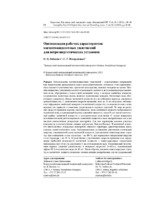Оптимизация рабочих характеристик магнитожидкостных уплотнений для ветроэнергетических установок

Date
2023Publisher
Another Title
Optimization of Performance Characteristics of Magnetofluidic Seals for Wind Power Plants
Bibliographic entry
Лабкович, О. Н. Оптимизация рабочих характеристик магнитожидкостных уплотнений для ветроэнергетических установок = Optimization of Performance Characteristics of Magnetofluidic Seals for Wind Power Plants / О. Н. Лабкович, С. Г. Погирницкая // Известия высших учебных заведений и энергетических объединений СНГ. Энергетика. – 2023. – № 1. – С. 80-90.
Abstract
Использование магнитожидкостных уплотнений – перспективное направление при герметизации вращающихся валов ветроэнергетических установок. Они характеризуются высокой герметичностью, простотой конструкции, низкими потерями на трение. Магнитожидкостное уплотнение состоит из кольцевого магнита и двух концентраторов магнитного поля, образующих с валом узкий кольцевой зазор, в котором магнитная жидкость, удерживаемая магнитным полем, является герметичным затвором. Магнитные силы обеспечивают равновесие объема магнитной жидкости под воздействием перепада давления и центробежных сил. С увеличением скорости вращения вала до 10 м/с визуально наблюдается деформация свободной поверхности магнитной жидкости у поверхности вала в виде воронки, что приводит к снижению удерживаемого перепада давлений. По мере возрастания скорости вращения воронка увеличивается, часть магнитной жидкости выбрасывается из рабочей зоны, удерживаемый перепад давлений снижается, и при 50 м/с происходит полный выброс магнитной жидкости и разгерметизация уплотнения. С целью повышения устойчивости свободной поверхности магнитной жидкости в поле центробежных сил в нее вводили многослойные углеродные нанотрубки. Для них характерны высокая удельная поверхность и соответственно сильное притяжение Ван-дер-Ваальса. В магнитной жидкости многослойные углеродные нанотрубки образуют структуры, ориентированные вдоль силовых линий магнитного поля. Экспериментально установлено увеличение статической нагрузки, удерживаемой слоем магнитной жидкости, при введении наноуглеродных структур: при совпадении с осью структуры – на 100 %, для нормального направления нагрузки к оси структуры – на 50 %. В уплотнении с увеличением скорости вращения вала деформация свободной поверхности магнитной жидкости с наноуглеродными структурами наблюдалась при 18 м/с на расстоянии 3 мм от поверхности вала. Удерживаемый уплотнением перепад давлений увеличивался в интервале скоростей 10–40 м/с, максимальный эффект 50 % получен при скорости 40 м/с. Таким образом, введение наноуглеродных структур в магнитную жидкость позволило снизить влияние центробежных сил на удерживаемый перепад давлений и повысить эффективность работы магнитожидкостного уплотнения при больших скоростях вращения вала ветроэнергетических установок.
Abstract in another language
The use of magnetofluidic seals are a promising direction in sealing rotating shafts of wind power plants. Magnetofluidic seals are characterized by high tightness, simplicity of the design, low losses by friction. Magnetic fluid seal of the rotating shaft consists of a ring magnet and two concentrators of magnetic field, forming with the shaft a narrow ring gap in which the magnetic fluid retained by magnetic field is a hermetic seal. Magnetic forces provide balance of volume of magnetic fluid under the impact of pressure drop and centrifugal forces. With an increase in the speed of rotation of the shaft up to 10 m/s, deformation of the free surface of the magnetic fluid at the surface of the shaft in the form of a funnel is visually observed, which causes a decrease in the retained pressure drop. As the rotation speed increases, the funnel increases, part of the magnetic fluid is ejected from the working area, the retained pressure drop decreases, and at 50 m/s there is a complete release of the magnetic fluid and depressurization of the seal. In order to increase the stability of the free surface of the magnetic fluid in the field of centrifugal forces, multilayer carbon nanotubes were introduced into it. They are characterized by a high specific surface area and, accordingly, a strong Van der Waals attraction. In a magnetic fluid, multilayer carbon nanotubes form structures which are oriented along the magnetic field lines. The following increase in the static load retained by a layer of magnetic fluid has been experimentally determined with the introduction of nanocarbon structures: when coinciding with the axis of the structures the increase was by 100 %, for the normal direction of the load to the axis of the structure – by 50 %. In the seal, with an increase in the shaft rotation speed, deformation of the free surface of a magnetic fluid with nanocarbon structures was observed at 18 m/s at a distance of 3 mm from the shaft surface. The pressure drop retained by the seal increased in the speed range of 10–40 m/s, the maximum effect of 50 % was obtained at a speed of 40 m/s. Thus, the introduction of nanocarbon structures into the magnetic fluid made it possible to reduce the influence of centrifugal forces on the retained pressure drop and increase the efficiency of the magnetofluidic seal at high speeds of rotation of the shaft of wind power plants.
View/
Collections
- № 1[8]
